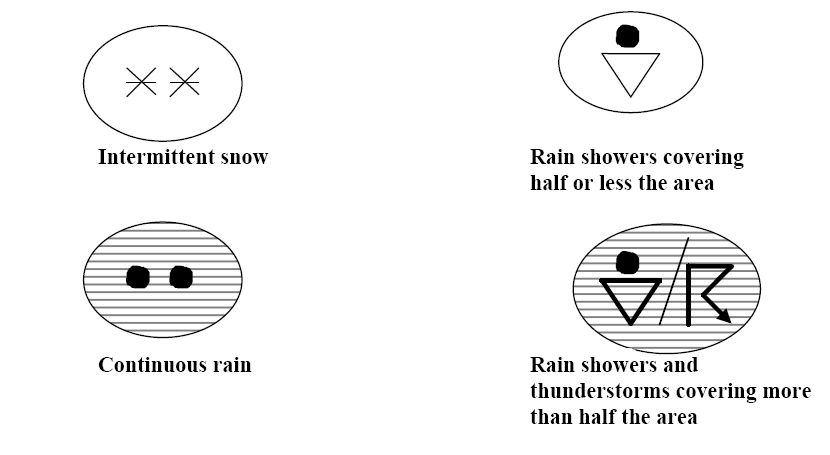
Tropical Cyclones The symbol depicts tropical cyclones. Severe squall lines depicted within areas of CB activity.

Severe Squall Line - Severe squall lines are lines of CB's of 5/8's coverage or greater and pose a significant hazard to aviation. Isolated (less than 1/8 area coverage) embedded cumulonimbus clouds with bases below FL240 and tops forecast to reach F元50. For example: Occasional (1/8 to 4/8 area coverage) embedded cumulonimbus clouds with bases below FL240 and tops forecast to reach FL450. The area the forecast applies to is enclosed by scalloped lines. Tops above the upper limits are shown as ABV 630.

CB tops are expressed in hundreds of feet MSL. Base and top of clouds are indicated by figures below and above a short line ( ).

The meanings of these area coverage terms are: ISOL (less than 1/8), OCNL (1/8 to 4/8) and FRQ (5/8 to 8/8). In rare instances, CB coverage above FL240 may exceed 4/8 coverage in these instances, CB activity will be described as FRQ CB (frequent cumulonimbus with little or no separation). The symbol "CB" automatically implies moderate or greater turbulence and icing and these conditions are not depicted separately.Ģ of 5 CB data will normally be identified as ISOL EMBD CB (isolated embedded CB), OCNL EMBD CB (occasional embedded CB), ISOL CB in HAZE (isolated CB in haze), or OCNL CB in HAZE (occasional CB in haze). It does not refer to isolated or scattered (occasional) cumulonimbus clouds that are not embedded in cloud layers or concealed by haze or dust. By definition, this symbol refers to either the occurrence or expected occurrence of an area of widespread cumulonimbus clouds along a line with little or no space between individual clouds or cumulonimbus clouds embedded in cloud layers or concealed by haze or dust. Thunderstorms and Associated Squall Lines - The abbreviation "CB", is used to depict possible thunderstorm activity. volcanic activity, including the name of the volcano, latitude and longitude, the date and time of the first eruption, and a reminder to check any SIGMETs forfurther information. surface positions, speed and direction of movement of frontal systems k. surface positions of well-defined convergence zones j. moderate or severe turbulence (in cloud or clear air) g. above flight level 250, cumulonimbus cloud associated with a) to c) above f. from 10,000 feet MSL to flight level 250, clouds associated with a) through c) above e.

These charts are issued at times as covered in the Low Level SIGWX Progs - The following weather is depicted on the charts: a. The High-Level Significant Weather Prog, encompasses airspace from 25,000 feet to 60,000 feet pressure altitude over the conterminous U.S., Mexico, Central America, portions of South America, the western Atlantic, and eastern Pacific. An important RAFC function is to supply users with forecast winds and temperatures aloft along with significant weather forecast charts. The main function of the NMC as a WAFS, is to prepare global forecasts in grid-point form of upper winds and upper air temperatures and to supply the forecasts to associated RAFCs. NMC is designated in the WAFS as both a World Area Forecast Center and a Regional Area Forecast Center (RAFC). National Meteorological Center (NMC), near Washington D.C., is a component of the World Area Forecast System (WAFS). 1 of 5 GUIDELINES TO HIGH LEVEL SIGNIFICANT WEATHER PROGNOSTIC CHARTS OBJECTIVES To examine and understand High Level SIGWX Charts Acquaint yourself with the symbols used in High Level SIGWX charts Practice reading the High Level SIGWX charts INTRODUCTION The High-Level Significant Weather Prog is derived from forecasts for both domestic and international flights.


 0 kommentar(er)
0 kommentar(er)
